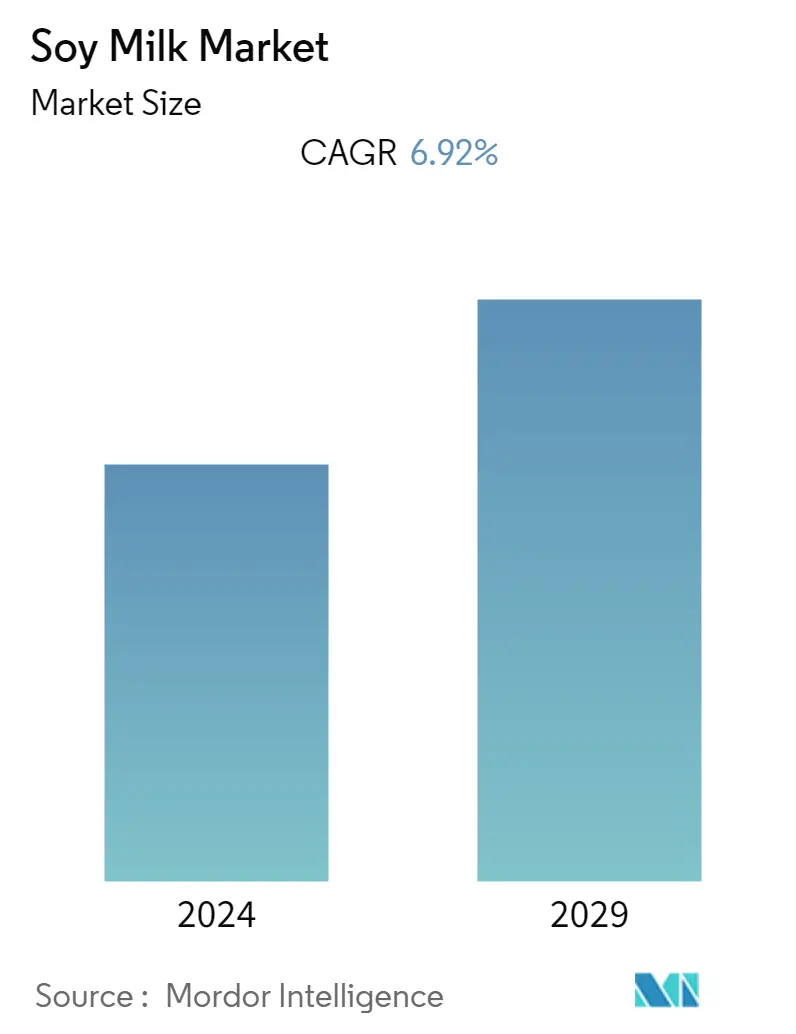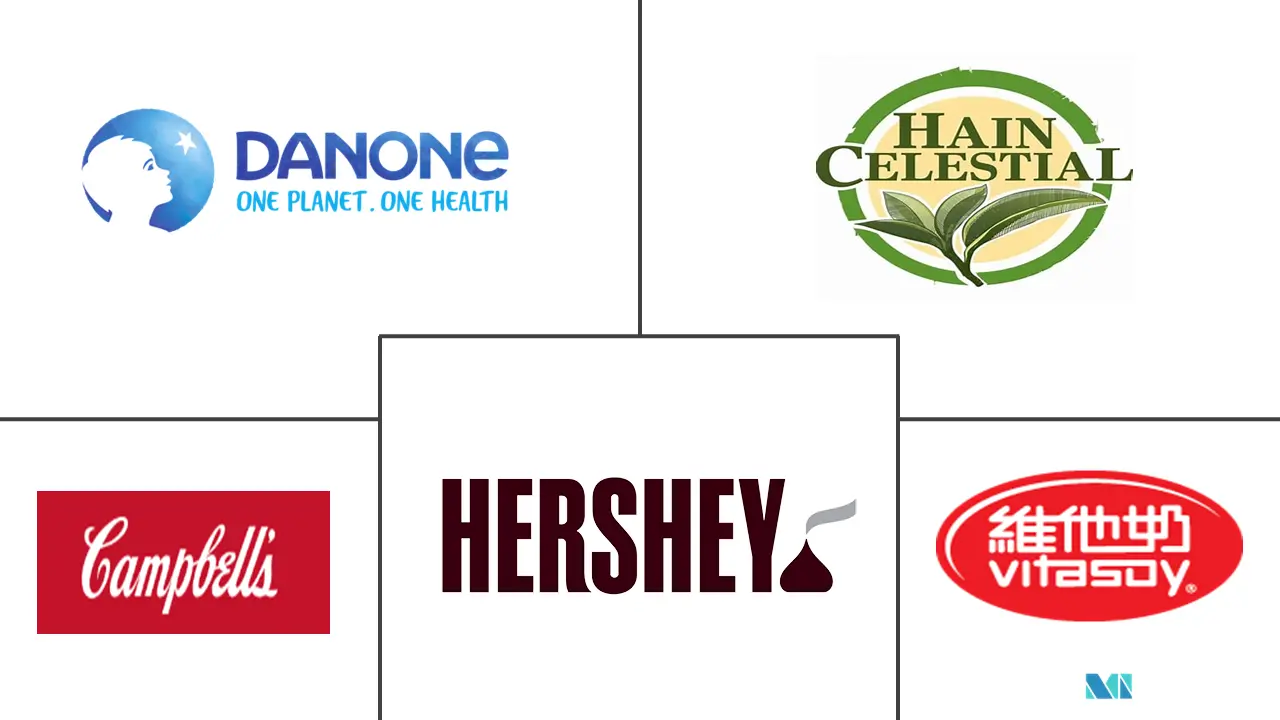Market Size of Soy Milk Industry

| Study Period | 2019 - 2029 |
| Base Year For Estimation | 2023 |
| CAGR | 6.92 % |
| Fastest Growing Market | Asia Pacific |
| Largest Market | Europe |
| Market Concentration | Low |
Major Players
*Disclaimer: Major Players sorted in no particular order |
Need a report that reflects how COVID-19 has impacted this market and its growth?
Soymilk Market Analysis
The soy milk market is projected to register a CAGR of 6.92% over the next five years.
- Consumers are beginning to prefer low-calorie products, free of artificial additives and high in protein, pushing the market for soy beverages. Plant-based beverages contain vegetable protein or a combination of proteins, which meet the growing need for a healthy lifestyle.
- Additionally, consumers are increasingly looking for lactose-free dairy alternatives made from plant sources due to rising lactose intolerance and the ongoing trend of veganism. The variety of goods on the shelves meets the taste for novelty and type of health and wellness-oriented consumers. Therefore, the plant-based beverages segment is promising with untapped potential in Asia-Pacific due to soy's traditional acceptance.
- Furthermore, soy milk is used extensively in Chinese, Japanese, Korean, and other East Asian cuisines. Soy milk is also used while producing imitation dairy products such as soy yogurt, soy cream, soy kefir, and soy-based cheese substitutes. It's also used to make milkshakes, pancakes, smoothies, bread, mayonnaise, and baked products.
- The manufacturers' introduction of various flavors like vanilla, chocolate, and strawberry, among others, to mask the aftertaste of soy milk is propelling the product demand among kids as well. Key manufacturers are investing in research and development to curb the aftertaste by introducing more flavors and selling the product in attractive packages via many distribution channels.
- For instance, The Hershey Company has been focused on introducing newer flavors like "Coffee Mocha" to its portfolio of "Sofit" beverages, i.e., soy milk drinks, to capture a larger audience and cater to their preferences and health at the same time.
Soymilk Industry Segmentation
Soy milk is a plant-based drink produced by soaking and grinding soybeans, boiling the mixture, and filtering out the remaining particulates. It is a stable emulsion of oil, water, and protein.
The Soy Milk market is segmented by product type, distribution channel, and geography. By product type, the market is segmented into flavored and unflavored. By distribution channel, the market is segmented into supermarkets/hypermarkets, convenience stores, online retailers, and others. By geography, the market is segmented into North America, Europe, Asia-Pacific, South America, Middle-East, and Africa.
The report offers market size and forecasts for the soy milk market in value (USD million) for all the above segments.
| Product Type | |
| Flavored Soy Milk | |
| Unflavored Soy Milk |
| Distribution Channel | |
| Supermarkets/Hypermarkets | |
| Convenience Stores | |
| Online Retailers | |
| Other Distribution Channels |
| Geography | |||||||||
| |||||||||
| |||||||||
| |||||||||
| |||||||||
|
Soy Milk Market Size Summary
The soy milk market is experiencing significant growth, driven by increasing consumer preference for low-calorie, protein-rich beverages free from artificial additives. This trend is largely fueled by the rising demand for lactose-free and vegan alternatives, as more individuals seek plant-based options due to lactose intolerance and the broader vegan movement. The market is particularly promising in the Asia-Pacific region, where soy milk is traditionally accepted and widely used in various cuisines. The introduction of diverse flavors and attractive packaging by manufacturers is further boosting the appeal of soy milk, especially among children. Key players are investing in research and development to enhance flavor profiles and expand distribution channels, thereby catering to the evolving tastes and health-conscious preferences of consumers.
The soy milk market is characterized by intense competition, with both regional and global players actively participating. Companies like Eden Food, The Hershey Company, and Vitasoy International Holdings are leading the charge, employing strategies such as product expansions and omnichannel distribution to broaden their market presence. The growing popularity of flavored soy milk is a testament to changing consumer tastes, which manufacturers are keen to capitalize on. Strategic investments in regions like Asia-Pacific, where demand for vegan and lactose-free products is on the rise, are further propelling market growth. The market's expansion is supported by the increasing availability of soy-based products and the ongoing trend towards health and wellness-oriented consumer choices.
Soy Milk Market Size - Table of Contents
-
1. MARKET DYNAMICS
-
1.1 Market Drivers
-
1.2 Market Restraints
-
1.3 Porter's Five Forces Analysis
-
1.3.1 Threat of New Entrants
-
1.3.2 Bargaining Power of Buyers/Consumers
-
1.3.3 Bargaining Power of Suppliers
-
1.3.4 Threat of Substitute Products
-
1.3.5 Intensity of Competitive Rivalry
-
-
-
2. MARKET SEGMENTATION
-
2.1 Product Type
-
2.1.1 Flavored Soy Milk
-
2.1.2 Unflavored Soy Milk
-
-
2.2 Distribution Channel
-
2.2.1 Supermarkets/Hypermarkets
-
2.2.2 Convenience Stores
-
2.2.3 Online Retailers
-
2.2.4 Other Distribution Channels
-
-
2.3 Geography
-
2.3.1 North America
-
2.3.1.1 United States
-
2.3.1.2 Canada
-
2.3.1.3 Mexico
-
2.3.1.4 Rest of North America
-
-
2.3.2 Europe
-
2.3.2.1 United Kingdom
-
2.3.2.2 Germany
-
2.3.2.3 France
-
2.3.2.4 Italy
-
2.3.2.5 Spain
-
2.3.2.6 Russia
-
2.3.2.7 Rest of Europe
-
-
2.3.3 Asia-Pacific
-
2.3.3.1 India
-
2.3.3.2 China
-
2.3.3.3 Japan
-
2.3.3.4 Australia
-
2.3.3.5 Rest of Asia-Pacific
-
-
2.3.4 South America
-
2.3.4.1 Brazil
-
2.3.4.2 Argentina
-
2.3.4.3 Rest of South America
-
-
2.3.5 Middle-East and Africa
-
2.3.5.1 Saudi Arabia
-
2.3.5.2 South Africa
-
2.3.5.3 Rest of Middle-East and Africa
-
-
-
Soy Milk Market Size FAQs
What is the current Soy Milk Market size?
The Soy Milk Market is projected to register a CAGR of 6.92% during the forecast period (2024-2029)
Who are the key players in Soy Milk Market?
Danone S.A., Campbell Soup Company, The Hershey Company, The Hain Celestial Group, Inc and Vitasoy International Holdings Limited are the major companies operating in the Soy Milk Market.

